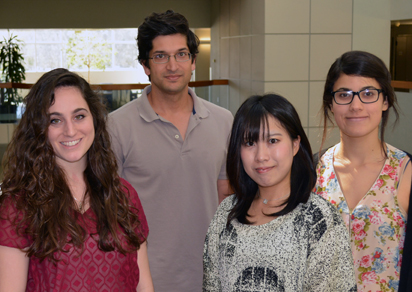Chemists Report Foundational New Chemical Reaction
Chemists at The Scripps Research Institute (TSRI) have developed a new type of chemical reaction that makes it easier to construct certain types of drug molecules and other chemical products.
The new reaction features a novel method for generating and controlling a “carbon radical” and is expected to lead to the invention of many other related molecule-building reactions.
“While the particular reaction we’ve demonstrated solves a very specific problem, it represents a foundation for a whole new set of reactions—I hope it’s considered a fundamental development,” said principal investigator Ryan A. Shenvi, associate professor of chemistry at TSRI.

Authors of the new paper include (left to right) Samatha Green, Ryan Shenvi, Akiko Yagi and Jeishla Matos. (Photo by Cindy Brauer.)
A Better Way to ‘Herd Cats’
The new method, published recently in the Journal of the American Chemical Society, harnesses a phenomenon called “hydrogen atom transfer” (HAT) to create and capture a carbon radical—a highly reactive type of molecule. The new technique enables the coupling of two very common types of organic molecules, arenes and olefins, but at a precise location on the olefin structure that has been difficult to target.
The extreme reactivity of radicals means that they tend to exist only fleetingly before vanishing. “Most molecules are like dogs: patient, compliant, obedient. Controlling radicals is more like herding cats,” said Shenvi. Previous examples of HAT managed this problem by surrounding the radicals with the desired reactant, adding very high concentrations of compounds that effectively keep carbon radicals from straying off the desired path. But this tends to limit the range and complexity of the coupling partners.
The new method instead uses tiny quantities of a nickel-containing catalyst to chemically “capture” the carbon radical in each reaction and coerce it into combining with the arene. “It’s like putting the cat into a pet carrier – now we can take it wherever we want,” said Shenvi.
The technique offers a relatively easy way to construct complex molecules with two widely available and generally inexpensive starting materials. It should be helpful, for example, in the construction of modified versions of existing drugs as well as entirely new drugs and chemical probes.
“In general, the HAT catalysts can tolerate nitrogen-atoms, which is valuable because nitrogen atoms are important to the activity of many drug molecules but tend to inhibit metal-catalyzed reactions,” said co-first author Jeishla L. M. Matos, a graduate student in the Shenvi laboratory.
‘Escaping Flatland’
Shenvi sees the reaction as particularly useful for adding a third dimension of structure to molecules that are otherwise flat. Some of the more popular reactions for molecule building in the pharmaceutical industry are limited to generating flat structures, and, although they are easy to carry out, the resulting candidate drugs have had low rates of success in clinical trials. “The new trend in drug design is to ‘escape flatland’ and attempt to create more complex 3D shapes—but there has been a lack of tools to do that,” Shenvi said.
He and his colleagues are now working on extending the basic HAT-plus-nickel concept to a host of other common reaction types. “We’ve started to look at alkyl halides, for example,” said co-first author Samantha A. Green, a graduate student in the Shenvi laboratory. “They’re harder to use as coupling partners, but if we can get this coupling to work effectively, we’ll be able to make what are called sp3-sp3 bonds, which are really important generally for building molecules.”
The new reaction harks back to two much older areas of chemistry. One, pioneered by American chemist Russell Drago and Japanese chemist Teruaki Mukaiyama in the 1980s, involves the use of metal catalysts to “hydrate”—or add a water molecule to—an olefin. The other, described by the University of Chicago chemist Jack Halpern in the 1950s, uses metal hydrides to transform petroleum byproducts into plastics and other useful chemical products. In a study [http://pubs.acs.org/doi/abs/10.1021/ja412342g] published in 2014, Shenvi and colleagues proposed that these two seemingly distinct sets of reactions essentially belong to the same family of HAT reactions.
Following that insight, Shenvi mused at a lab outing last Christmas about the possibility of using HAT to achieve a better method of coupling arenes and olefins. Green and Matos, along with Research Associate Akiko Yagi, took up the challenge and—despite Shenvi’s warnings about the difficulties and the intense competition from other labs with more experience in this area—succeeded within several months.
“They deserve more credit than I do—they really went into unknown territory,” Shenvi said.
Funding for the study, “Branch-Selective Hydroarylation: Iodoarene−Olefin Cross-Coupling,” was provided by the National Science Foundation (grant GRFP 171), the Japan Society for the Promotion of Science, Eli Lilly, Novartis, Bristol-Myers Squibb, Amgen, Boehringer-Ingelheim, the Alfred P. Sloan Foundation and the Baxter Foundation.
Send comments to: press[at]scripps.edu













